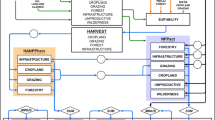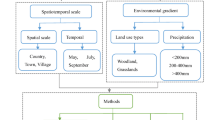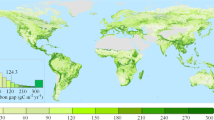Abstract
In this study, we investigated the impact of human settlement growth on vegetation carbon uptake in the eastern United States between 1992/1993 and 2001. Human settlement growth was measured by changes in the density of housing units. Vegetation carbon uptake was estimated with gross primary production (GPP) based on the light-use efficiency approach applied to satellite imagery. Annual GPP was found to increase by approximately 140 g C m−2 on average for the entire study area in 2001 compared to 1992/1993, accompanied by region-wide increases in downward shortwave radiation and minimum daily temperature. Changes in GPP, however, varied significantly by different types of settlement growth. Exurbanized areas, where the rural settlement (less than 0.025 units per acre) converted to exurbs (0.025–0.6 units per acre), were associated with approximately 157 g C m−2 increase in GPP due to high vegetation proportions. Suburbanization, the conversion from exurban settlement to suburbs (0.6–4 units per acre), was related with a decline of GPP by 152 g C m−2 due to progressive development of built-up land cover. Results help to understand the potential of carbon mitigation in the human-dominated landscapes using vegetation as a natural store of carbon dioxide. This in turn has implications for the low-carbon development planning along the gradient of human settlement densities.



Similar content being viewed by others
References
Albani M, Medvigy D, Hurtt GC, Moorcroft PR (2006) The contributions of land-use change, CO2 fertilization, and climate variability to the Eastern US carbon sink. Glob Change Biol 12(12):2370–2390
Arora VK, Boer GJ (2010) Uncertainties in the 20th century carbon budget associated with land use change. Glob Change Biol 16:3327–3348
Baldocchi D, Falge E, Gu LH, Olson R, Hollinger D, Running S, Anthoni P, Bernhofer C, Davis K, Evans R, Fuentes J, Goldstein A, Katul G, Law B, Lee XH, Malhi Y, Meyers T, Munger W, Oechel W, U KTP, Pilegaard K, Schmid HP, Valentini R, Verma S, Vesala T, Wilson K, Wofsy S (2001) FLUXNET: a new tool to study the temporal and spatial variability of ecosystem-scale carbon dioxide, water vapor, and energy flux densities. Bull Am Meteorol Soc 82(11):2415–2434
Bierwagen BG, Theobald DM, Pyke CR, Choate A, Groth P (2010) National housing and impervious surface scenarios for integrated climate impact assessments. Proc Natl Acad Sci USA 107(49):20887–20892
Brown DG, Johnson KM, Loveland TR, Theobald DM (2005) Rural land-use trends in the conterminous United States, 1950–2000. Ecol Appl 15(6):1851–1863
Chapin FS, Matson PA, Mooney HA (2002) Principles of terrestrial ecosystem ecology. Springer, New York
Churkina G (2008) Modeling the carbon cycle of urban system. Ecol Model 216:107–113
Churkina G, Brown DG, Keoleian G (2010) Carbon stored in human settlements: the conterminous United States. Glob Change Biol 16(1):135–143
Clark JK, McChesney R, Munroe DK, Irwin EG (2009) Spatial characteristics of exurban settlement pattern in the United States. Landsc Urban Plan 90(3–4):178–188
Cramer W, Kicklighter DW, Bondeau A, Moore B, Churkina G, Nemry B, Ruimy A, Schloss AL (1999) Comparing global models of terrestrial net primary productivity (NPP): overview and key results. Glob Change Biol 5(suppl. 1):1–15
DeGrove JM (2005) Planning policy and politics: smart growth and the states. Lincoln Institute of Land Policy, Cambridge
Dilling L (2007) Towards science in support of decision making: characterizing the supply of carbon cycle science. Environ Sci Policy 10(1):48–61
Dvorak B, Volder A (2010) Green roof vegetation findings for North American ecoregions: a literature review. Landsc Urban Plan 97:146
Elvidge CD, Imhoff ML, Baugh KE, Hobson VR, Nelson I, Safran J, Dietz JB, Tuttle BT (2001) Night-time lights of the world: 1994–1995. ISPRS J Photogramm Remote Sens 56(2):81–99
Erb KH, Krausmann F, Gaube V, Gingrich S, Bondeau A, Fischer-Kowalski M, Haberl H (2009) Analyzing the global human appropriation of net primary production—processes, trajectories, implications. An introduction. Ecol Econ 69(2):250–259
Ewing R, Bartholomew K, Winkelman S, Walters J, Chen D (2008) Growing Coller: the evidence on urban development and climate change. The Urban Land Institute, Washington, DC
Fry JA, Coan MJ, Homer CG, Meyer DK, Wickham JD (2009) Completion of the National Land Cover Database (NLCD) 1992–2001 Land Cover Change Retrofit product. U.S. Geological Survey open-file report 2008-1379
Gower ST, Kucharik CJ, Norman JM (1999) Direct and indirect estimation of leaf area index, fAPAR and net primary production of terrestrial ecosystems. Remote Sens Environ 70:29–51
Granger RJ (1991) Evaporation from natural nonsaturated surfaces. PhD thesis. University of Saskatchewan
Grimm NB, Faeth SH, Golubiewski NE, Redman CL, Wu JG, Bai XM, Briggs JM (2008a) Global change and the ecology of cities. Science 319(5864):756–760
Grimm NB, Foster D, Groffman P, Grove JM, Hopkinson CS, Nadelhoffer KJ, Pataki DE, Peters DPC (2008b) The changing landscape: ecosystem responses to urbanization and pollution across climatic and societal gradients. Front Ecol Environ 6(5):264–272
Guindon B, Zhang Y, Dillabaugh C (2004) Landsat urban mapping based on a combined spectral-spatial methodology. Remote Sens Environ 92(2):218–232
Heinsch FA, Reeves M, Votava P, Kang S, Milesi C, Zhao M, Glassy J, Jolly WM, Loehman R, Bowker CF, Kimball JS, Nemani RR, Running SW (2003) User’s guide, GPP and NPP (MOD 17A2/A3) products, NASA MODIS land algorithm. Version 2.0, December 2, 2003
Heinsch FA, Zhao MS, Running SW, Kimball JS, Nemani RR, Davis KJ, Bolstad PV, Cook BD, Desai AR, Ricciuto DM, Law BE, Oechel WC, Kwon H, Luo HY, Wofsy SC, Dunn AL, Munger JW, Baldocchi DD, Xu LK, Hollinger DY, Richardson AD, Stoy PC, Siqueira MBS, Monson RK, Burns SP, Flanagan LB (2006) Evaluation of remote sensing based terrestrial productivity from MODIS using regional tower eddy flux network observations. IEEE Trans Geosci Remote Sens 44(7):1908–1925
Homer C, Dewitz J, Fry J, Coan M, Hossain N et al (2007) Completion of the 2001 National Land Cover Database for the conterminous United States. Photogramm Eng Remote Sens 73(4):337–341
Houghton RA, Davidson EA, Woodwell GM (1998) Missing sinks, feedbacks, and understanding the role of terrestrial ecosystems in the global carbon balance. Global Biogeochem Cycles 12(1):25–34
Houghton RA, Hackler JL, Lawrence KT (1999) The US carbon budget: contributions from land-use change. Science 285(5427):574–578
Huang C, Homer C, Yang L (2003) Regional forest land cover characterization using Landsat type data. In: Wulder M, Franklin S (eds) Methods and applications for remote sensing of forests: concepts and case studies. Kluwer Academic Publishers, Dordrecht, pp 389–410
Huete A, Didan K, Miura T, Rodriguez EP, Gao X, Ferreira LG (2002) Overview of the radiometric and biophysical performance of the MODIS vegetation indices. Remote Sens Environ 83:195–213
Hutyra LR, Yoon B, Alberti M (2010) Terrestrial carbon stocks across a gradient of urbanization: a study of the Seattle, WA region. Glob Change Biol 17(2):783–797
Imhoff ML, Tucker CJ, Lawrence WT, Stutzer DC (2000) The use of multisource satellite and geospatial data to study the effect of urbanization on primary productivity in the United States. IEEE Trans Geosci Remote Sens 38(6):2549–2556
Imhoff ML, Bounoua L, DeFries R, Lawrence WT, Stutzer D, Tucker CJ, Ricketts T (2004) The consequences of urban land transformation on net primary productivity in the United States. Remote Sens Environ 89:434–443
Knyazikhin Y, Glassy J, Privette JL, Tian Y, Lotsch A, Zhang Y, Wang Y, Morisette JT, Votava P, Mneni RB, Nemani RR, Running SW (1999) MODIS leaf area index (LAI) and fraction of photosynthetically active radiation absorbed by vegetation (FPAR) product (MOD15) algorithm theoretical basis document. http://modis.gsfc.nasa.gov/data/atbd/atbd_mod15.pdf. Accessed 19 Oct 2009
Lambers H, Chapin FS, Pons TL (1998) Plant physiology ecology. Springer, New York, pp 15–20, 86
Lobell DB, Hicke JA, Asner GP, Field CB, Tucker CJ, Los SO (2002) Satellite estimates of productivity and light use efficiency in United States agriculture, 1982–98. Glob Change Biol 8(8):722–735
Milesi C, Elvidge CD, Nemani RR, Running SW (2003) Assessing the impact of urban land development on net primary productivity in the southeastern United States. Remote Sens Environ 86:401–410
Mitchell KE, Lohmann D, Houser PR, Wood EF, Schaake JC et al (2004) The multi-institution North American Land Data Assimilation System (NLDAS): utilizing multiple GCIP products and partners in a continental distributed hydrological modeling system. J Geophys Res Atmos 109(D7):D07S90
Monteith JL (1972) Solar radiation and productivity in tropical ecosystems. J Appl Ecol 9:747–766
Nowak DJ, Crane DE (2002) Carbon storage and sequestration by urban trees in the USA. Environ Pollut 116:381–389
Omernick JM (1987) Ecoregions of the conterminous United States. Ann Assoc Am Geogr 77(1):118–125
Pataki DE, Alig RJ, Fung AS, Golubiewski NE, Kennedy CA, McPherson EG, Nowak DJ, Pouyat RV, Lankao PR (2006) Urban ecosystems and the North American carbon cycle. Glob Change Biol 12:2092–2102
Pataki DE, Emmi PC, Forster CB, Mills JI, Pardyjak ER, Peterson TR, Thompson JD, Dudley-Murphy E (2009) An integrated approach to improving fossil fuel emissions scenarios with urban ecosystem studies. Ecol Complex 6(1):1–14
Pontius RG, Peethambaram S, Castella JC (2011) Comparison of three maps at multiple resolutions: a case study of land change simulation in Cho Don District, Vietnam. Ann Assoc Am Geogr 101(1):45–62
Porter DR (2008) Managing growth in America’s communities, 2nd edn. Island Press, Washington, DC
Potter CS, Randerson JT, Field CB, Matson PA, Vitousek PM, Mooney HA, Klooster SA (1993) Terrestrial ecosystem production—a process model-based on global satellite and surface data. Global Biogeochem Cycles 7(4):811–841
Prince SD, Goward SN (1995) Global primary production: a remote sensing approach. J Biogeogr 22:815–835
Ramachandran S, Ramaswamy V, Stenchikov GL, Robock A (2000) Radiative impact of the Mount Pinatubo volcanic eruption: lower stratospheric response. J Geophys Res 105(19):24409–24429
Robinson DT, Brown DG, Currie WS (2009) Modelling carbon storage in highly fragmented and human-dominated landscapes: linking land-cover patterns and ecosystem models. Ecol Model 220(9–10):1325–1338
Running SW, Thornton P, Nemani ER, Glassy JM (2000) Global terrestrial gross and net primary productivity from the Earth Observing System. In: Sala OE, Jackson RB, Mooney HA, Howarth RW (eds) Methods in ecosystem science. Springer, New York, pp 44–57
Running SW, Nemani RR, Heinsch FA, Zhao M, Reeves M, Hashimoto H (2004) A continuous satellite-derived measure of global terrestrial primary production. Bioscience 54:547–560
Schwalm CR, Black TA, Arniro BD, Arain MA, Barr AG, Bourque CPA, Dunn AL, Flanagan LB, Giasson MA, Lafleur PM, Margolis HA, McCaughey JH, Orchansky AL, Wofsy SC (2006) Photosynthetic light use efficiency of three biomes across an east-west continental-scale transect in Canada. Agric For Meteorol 140(1–4):269–286
Scurlock JMO, Olson RJ (2002) Terrestrial net primary productivity—a brief history and a new worldwide database. Environ Rev 10:91–109
Sitch S, Smith B, Prentice IC, Arneth A, Bondeau A, Cramer W, Kaplan JO, Levis S, Lucht W, Sykes MT, Thonicke K, Venevsky S (2003) Evaluation of ecosystem dynamics, plant geography and terrestrial carbon cycling in the LPJ dynamic global vegetation model. Glob Change Biol 9(2):161–185
Syphard AD, Stewart SI, McKeefry J, Hammer RB, Fried JS, Holcomb S, Radeloff VC (2009) Assessing housing growth when census boundaries change. Int J Geogr Inf Sci 23(7):859–876
Theobald DM (2001) Land-use dynamics beyond the American urban fringes. Geogr Rev 91(3):544–564
Theobald DM (2005) Landscape patterns of exurban growth in the USA from 1980 to 2020. Ecol Soc 10(1):32
Tucker CJ, Slayback DA, Pinzon JE, Los SO, Myneni RB, Taylor MG (2001) Higher northern latitude normalized difference vegetation index and growing season trends from 1982 to 1999. Int J Biometeorol 45:184–190
Turner DP, Ritts WD, Cohen WB, Maeirsperger TK, Gower ST, Kirschbaum AA, Running SW, Zhao MS, Wofsy SC, Dunn AL, Law BE, Campbell JL, Oechel WC, Kwon HJ, Meyers TP, Small EE, Kurc SA, Gamon JA (2005) Site-level evaluation of satellite-based global terrestrial gross primary production and net primary production monitoring. Glob Change Biol 11(4):666–684
Turner BL, Lambin EF, Reenberg A (2007) The emergence of land change science for global environmental change and sustainability. Proc Natl Acad Sci USA 104:20666–20671
U.S. Census Bureau (1995) Urban and rural population: 1900 to 1990. http://www.census.gov/population/censusdata/urpop0090.txt. Accessed 10 Sept 2009
U.S. Census Bureau (2009) Current population survey, March and annual social and economic supplements, 2008 and earlier. http://www.census.gov/population/www/socdemo/hh-fam.html#ht. Accessed 10 Sept 2009
U.S.G.S. EROS Data Center (2006) The conterminous U.S. and Alaska weekly and biweekly AVHRR composites. EROS Data Center, Sioux Falls
Vogelmann JE, Howard SM, Yang L, Larson CR, Wylie BK, Van Driel N (2001) Completion of the 1990s national land cover data set for the conterminous United States from Landsat thematic mapper data and ancillary data sources. Photogramm Eng Remote Sens 67:650–652
Wentz EA, Gober P, Balling RC, Day TA (2002) Spatial patterns and determinants of winter atmospheric carbon dioxide concentrations in an urban environment. Ann Assoc Am Geogr 92:15–28
Wu JG (2004) Effects of changing scale on landscape pattern analysis: scaling relations. Landscape Ecol 19:125–138
Wu JG (2010) Urban sustainability: an inevitable goal of landscape research. Landscape Ecol 25:1–4
Xiao J, Zhuang Q, Law BE, Chen J, Baldocchi DD, Cook DR, Oren R, Richardson AD, Wharton S, Ma SY, Martin TA, Verma SB, Suyker AE, Scott RL, Monson RK, Litvak M, Hollinger DY, Sun G, Davis KJ, Bolstad PV, Burns SP, Curtis PS, Drake BG, Falk M, Fischer ML, Foster DR, Gu LH, Hadley JL, Katul GG, Roser Y, McNulty S, Meyers TP, Munger JW, Noormets A, Oechel WC, Paw KT, Schmid HP, Starr G, Torn MS, Wofsy SC (2010) A continuous measure of gross primary production for the conterminous United States derived from MODIS and AmeriFlux data. Remote Sens Environ 114:576–591
Yang L, Huang C, Homer CG, Wylie BK, Coan MJ (2003) An approach for mapping large-area impervious surfaces: synergistic use of Landsat-7 ETM and high spatial resolution imagery. Can J Remote Sens 29(2):230–240
Yang FH, Ichii K, White MA, Hashimoto H, Michaelis AR, Votava P, Zhu AX, Huete A, Running SW, Nemani RR (2007) Developing a continental-scale measure of gross primary production by combing MODIS and AmeriFlux data through Support Vector Machine approach. Remote Sens Environ 110:109–122
Zhang C, Tian H, Pan S, Liu M, Lockaby G, Schilling EB, Stanturf J (2008) Effects of forest regrowth and urbanization on ecosystem carbon storage in a rural-urban gradient in the Southeastern United States. Ecosystems 11:1211–1222
Zhao M, Running SW (2010) Drought-induced reduction in global terrestrial net primary production from 2000 through 2009. Science 329(5994):940–943
Zhao M, Heinsch FA, Nemani RR, Running SW (2005) Improvements of the MODIS terrestrial gross and net primary production global data set. Remote Sens Environ 95:164–176
Zhao TT, Brown DG, Bergen KM (2007) Increasing gross primary production (GPP) in the urbanizing landscapes of southeastern Michigan. Photogramm Eng Remote Sens 73(10):1159–1167
Zhao TT, Horner MW, Sulik J (2011) A geographic approach to sectoral carbon inventory: examining the balance between consumption-based emissions and land-use carbon sequestration in Florida. Ann Assoc Am Geogr 101(4):752–763
Acknowledgments
Part of the research was funded by the 2008 First-Year Assistant Professor summer grant at Florida State University. The climate data used in this study was acquired as part of the activities of NASA’s Science Mission Directorate, and are archived and distributed by the Goddard Earth Sciences (GES) Data and Information Services Center (DISC). We would also like to extend our gratitude to Lisa A. Schulte and the anonymous reviewers.
Author information
Authors and Affiliations
Corresponding author
Electronic supplementary material
Below is the link to the electronic supplementary material.
Rights and permissions
About this article
Cite this article
Zhao, T., Brown, D.G., Fang, H. et al. Vegetation productivity consequences of human settlement growth in the eastern United States. Landscape Ecol 27, 1149–1165 (2012). https://doi.org/10.1007/s10980-012-9766-8
Received:
Accepted:
Published:
Issue Date:
DOI: https://doi.org/10.1007/s10980-012-9766-8




